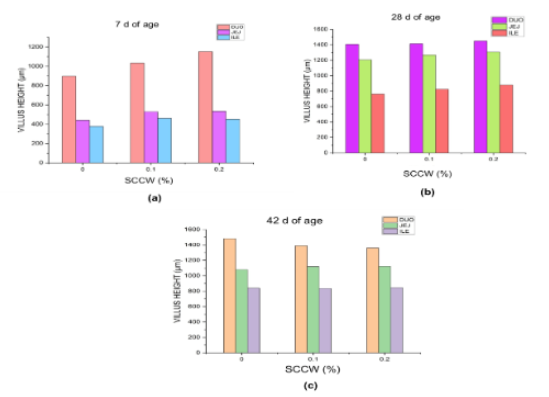The impacts of Saccharomyces Cerevisiae Cell Wall on Broiler Chicken Productivity and Gastrointestinal Mucosa Development
Abstract
The use of antibiotics in chicken intakes to promote growth has been compared to resistance to bacteria and the emergence of novel management of product strategies. The Saccharomyces cerevisiae cell wall (SCCW), which is made up of complex carbohydrates, proteins, nucleic acids, and minerals, has demonstrated significant advantages in animal feeding. Its constituents' prebiotic characteristics, especially the mannans, and glucans, have been found to improve nutrient digestibility and promote the development of advantageous gut microbes. The goal of this study aimed to assess the growth and development of the intestinal mucosa of broiler chickens fed diets according to maize and soybean meal that contained a novel material (SCCW var. Calsberg) derived from the brewing industry. The findings of investigation 1 (conducted in litter-floor pens) showed that the birds had given 0.2% SCCW gained more body weight overall and had greater villus heights at 7 days of age. Field testing with 44,000 broilers who consumed food with 0.2% SCCW also revealed that the SCCW-supplemented birds had increased physical weight gains and improved conversion of feed. According to the current research, SCCW increased the body weight of broiler chickens. This improvement can be linked to the product's trophic gastrointestinal mucosa being affected, which raises the height of the villus, particularly in the first week of a chicken's life.
References
[2] Lin, D. and Medeiros, D.M., 2023. The microbiome is a major function of the gastrointestinal tract and its implication in micronutrient metabolism and chronic diseases. Nutrition Research.
[3] Zige, V.D. and Ofongo, R.T.S., 2019. In-vitro Antibiotic activity of dry ginger root extract against potential enteropathogenic Bacteria isolated from two Weeks old Broiler Chickens. International Journal of Environment, Agriculture and Biotechnology, 4(1), pp.229-232.
[4] Farkas, V., Csitári, G., Menyhárt, L., Such, N., Pál, L., Husvéth, F., Rawash, M.A., Mezőlaki, Á. and Dublecz, K., 2022. Microbiota composition of mucosa and interactions between the microbes of the different gut segments could be a factor in modulating the growth rate of broiler chickens. Animals, 12(10), p.1296.
[5] Ahiwe, E.U., Abdallh, M.E., Chang’a, E.P., Omede, A.A., Al-Qahtani, M., Gausi, H., Graham, H. and Iji, P.A., 2020. Influence of dietary supplementation of autolyzed whole yeast and yeast cell wall products on broiler chickens. Asian-Australasian Journal of Animal Sciences, 33(4), p.579.
[6] Arif, M., Iram, A., Bhutta, M.A., Naiel, M.A., Abd El-Hack, M.E., Othman, S.I., Allam, A.A., Amer, M.S. and Taha, A.E., 2020. The biodegradation role of Saccharomyces cerevisiae against harmful effects of mycotoxin contaminated diets on broiler performance, immunity status, and carcass characteristics. Animals, 10(2), p.238.
[7] dos Santos, V.M., da Silva Oliveira, G., de Lima, C.A.R. and Curvello, F.A., 2021. Broiler chick performance using Saccharomyces cerevisiae yeast cell wall as an anti-mycotoxin additive. Czech Journal of Animal Science, 66(2), pp.65-72.
[8] Kong, Y., Olejar, K.J., On, S.L., Winefield, C., Wescombe, P.A., Brennan, C.S., Hider, R.N. and Chelikani, V., 2022. Epigenetic Changes in Saccharomyces cerevisiae Alters the Aromatic Profile in Alcoholic Fermentation. Applied and Environmental Microbiology, 88(23), pp.e01528-22.
[9] Ballet, N., Renaud, S., Roume, H., George, F., Vandekerckove, P., Boyer, M. and Durand-Dubief, M., 2023. Saccharomyces cerevisiae: Multifaceted Applications in One Health and the Achievement of Sustainable Development Goals. Encyclopedia, 3(2), pp.602-613.
[10] Kamel, N.F., Hady, M.M., Ragaa, N.M. and Mohamed, F.F., 2021. Effect of nucleotides on growth performance, gut health, and some immunological parameters of broiler chicken exposed to high stocking density. Livestock Science, 253, p.104703.
[11] Rajput, D.S., Zeng, D., Khalique, A., Rajput, S.S., Wang, H., Zhao, Y., Sun, N. and Ni, X., 2020. Pretreatment with probiotics ameliorate gut health and necrotic enteritis in broiler chickens, a substitute to antibiotics. AMB Express, 10, pp.1-11.
[12] Shehata, A.M., Paswan, V.K., Attia, Y.A., Abdel-Moneim, A.M.E., Abougabal, M.S., Sharaf, M., Elmazoudy, R., Alghafari, W.T., Osman, M.A., Farag, M.R. and Alagawany, M., 2021. Managing gut microbiota through in ovo nutrition influences early-life programming in broiler chickens. Animals, 11(12), p.3491.
[13] Bogusławska-Tryk, M., Ziółkowska, E., Sławińska, A., Siwek, M. and Bogucka, J., 2021. Modulation of intestinal histology by probiotics, prebiotics and synbiotics delivered in ovo in distinct chicken genotypes. Animals, 11(11), p.3293.
[14] López-García, Y.R., Gómez-Rosales, S., Angeles, M.D.L., Jiménez-Severiano, H., Merino-Guzman, R. and Téllez-Isaias, G., 2023. Effect of the Addition of Humic Substances on Morphometric Analysis and Number of Goblet Cells in the Intestinal Mucosa of Broiler Chickens. Animals, 13(2), p.212.
[15] Wan, S., Sun, N., Li, H., Khan, A., Zheng, X., Sun, Y. and Fan, R., 2022. Deoxynivalenol damages the intestinal barrier and biota of the broiler chickens. BMC Veterinary Research, 18(1), pp.1-10.
[16] Bi, S., Zhang, J., Zhang, L., Huang, K., Li, J. and Cao, L., 2022. Yeast cell wall upregulated cell-mediated immune responses to Newcastle disease virus vaccine. Poultry Science, 101(4), p.101712.
[17] Conlon, N., Murphy, R.A., Corrigan, A., Doyle, S., Owens, R.A. and Fagan, S., 2022. Quantitative Proteomic Analysis Reveals Yeast Cell Wall Products Influence the Serum Proteome Composition of Broiler Chickens. International Journal of Molecular Sciences, 23(19), p.11844.
[18] Ashry, A., Taha, N.M., Lebda, M.A., Abdo, W., El-Diasty, E.M., Fadl, S.E. and Morsi Elkamshishi, M., 2022. Ameliorative effect of nanocurcumin and Saccharomyces cell wall alone and in combination against aflatoxicosis in broilers. BMC Veterinary Research, 18(1), pp.1-18.
[19] Puvača, N., Tufarelli, V. and Giannenas, I., 2022. Essential oils in broiler chicken production, immunity and meat quality: Review of Thymus vulgaris, Origanum vulgare, and Rosmarinus officinalis. Agriculture, 12(6), p.874.
[20] Brandejs, V., Kupcikova, L., Tvrdon, Z., Hampel, D. and Lichovnikova, M., 2022. Broiler chicken production using dietary crude protein reduction strategy and free amino acid supplementation. Livestock Science, 258, p.104879.







